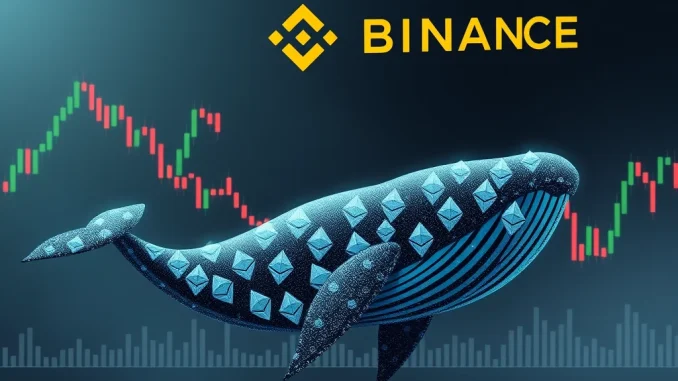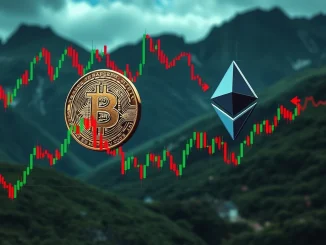
Ever wondered what moves the crypto markets? Sometimes, it’s the big players – the crypto whales. Just moments ago, a significant transaction flashed across the blockchain, catching the attention of eagle-eyed analysts. A crypto whale, identified as ‘qklpj.eth,’ just deposited a staggering 6,595.8 ETH, valued at a cool $12 million, into the Binance exchange. This news has sent ripples through the crypto community, prompting the burning question: What does this whale move mean for the price of ETH and the broader market?
Why are Crypto Whale Deposits to Binance Significant?
When we talk about crypto deposits to exchanges, especially from large holders or ‘whales,’ it’s crucial to understand the potential implications. Think of it like this: exchanges are often seen as marketplaces for selling crypto assets. Therefore, a large influx of crypto into an exchange can sometimes indicate an intent to sell. This is precisely why on-chain analysts like @EmberCN, who first flagged this whale transaction on X, pay close attention to these movements.
Here’s a breakdown of why these whale movements matter:
- Market Sentiment Indicator: Large deposits can be interpreted as a bearish signal, suggesting that a major holder anticipates a price decrease and is looking to offload their holdings.
- Potential Price Impact: When a whale dumps a significant amount of ETH on the market, it can increase selling pressure, potentially leading to price drops, at least in the short term.
- Liquidity Dynamics: Large deposits can affect the liquidity of an asset on an exchange. Increased supply can sometimes lead to wider bid-ask spreads.

Decoding the Whale’s ETH Source: Renzo Restaking Protocol
This particular whale deposit has an interesting backstory. According to @EmberCN’s analysis, the 6,595.8 ETH wasn’t just pulled from cold storage. It was redeemed from the Renzo restaking protocol. But what exactly is Renzo, and why does this detail matter?
Renzo is a restaking protocol built on Ethereum. In simple terms, restaking allows users who have staked their ETH to earn additional yield by participating in the security of other networks or services. It’s like putting your staked ETH to work in multiple ways to maximize returns. Redeeming ETH from a restaking protocol like Renzo suggests the whale was previously engaged in yield-generating activities with this ETH.
Here’s why the Renzo connection is noteworthy:
- Profit Taking: The whale might be taking profits after a period of earning yield through restaking. This is a common and rational investment strategy.
- Portfolio Rebalancing: Redeeming from Renzo and depositing to Binance could be part of a broader portfolio rebalancing strategy. The whale might be shifting assets to different platforms or asset classes.
- Strategic Move: It’s also possible the whale is repositioning their ETH for other opportunities within the Binance ecosystem, which offers a wide range of trading and investment products.
Sell Signal or Strategic Shift? Unpacking Crypto Deposits
While deposits to exchanges are often interpreted as sell signals, it’s crucial to avoid jumping to conclusions. The crypto market is nuanced, and whale transactions are no exception. Not every deposit to an exchange translates to an immediate sell-off. There are several other reasons why a whale might move ETH to Binance:
- Trading Opportunities: Binance offers advanced trading tools and a wide range of trading pairs. The whale might be moving ETH to capitalize on specific trading opportunities, such as arbitrage or taking advantage of market volatility.
- Margin Trading: Exchanges like Binance offer margin trading, which allows users to trade with leverage. The whale might be depositing ETH as collateral for margin trading activities.
- Liquidity Provision: Some large holders participate in liquidity provision on exchanges, earning fees for facilitating trades. Depositing ETH could be for this purpose.
- OTC (Over-the-Counter) Trading: Binance also facilitates OTC trading for large volumes. The deposit might be related to an OTC deal, where the actual sale happens off the exchange’s order books.
Withdrawals vs. Deposits: Decoding Crypto Whale Behavior
To further understand whale behavior, it’s helpful to contrast deposits with withdrawals. As a general rule of thumb:
- Deposits to Exchanges: Often seen as a potential indication of selling pressure. However, as discussed, this is not always the case and can be for various strategic reasons.
- Withdrawals from Exchanges: Typically signal a holding strategy. When whales withdraw crypto from exchanges to private wallets, it suggests they intend to hold onto their assets for the longer term, potentially anticipating future price appreciation.
Keeping an eye on the balance between exchange inflows and outflows can provide valuable insights into overall market sentiment and potential price movements. Tools like on-chain analytics platforms and exchange flow trackers are invaluable for monitoring these trends.
Actionable Insights: How to Interpret Whale ETH Movements
So, what can we learn from this whale‘s $12 million ETH deposit to Binance? Here are some actionable insights for crypto enthusiasts and investors:
- Context is Key: Don’t react impulsively to every whale deposit. Consider the context, such as the source of the funds (e.g., Renzo redemption), overall market conditions, and other on-chain metrics.
- Monitor On-Chain Data: Utilize on-chain analytics tools to track whale movements, exchange flows, and other relevant data points. This can provide a more informed perspective on market trends.
- Diversify Information Sources: Don’t rely solely on single data points. Combine on-chain analysis with technical analysis, fundamental analysis, and news sentiment to form a comprehensive view.
- Manage Risk: Whale activity can contribute to market volatility. Ensure your portfolio is well-diversified and your risk management strategies are in place to navigate potential price swings.
Conclusion: The Crypto Whale Dance – Speculation and Strategy
The recent whale deposit of $12 million in ETH to Binance serves as a timely reminder of the dynamic and often unpredictable nature of the cryptocurrency market. While it sparks immediate speculation about potential sell-offs, a deeper dive reveals a more complex picture involving strategic portfolio management, yield optimization, and diverse trading motives. Following these whale movements, while not a foolproof predictor, offers fascinating glimpses into the minds of major market participants and underscores the importance of staying informed and adaptable in the ever-evolving crypto landscape. Keep watching the blockchain, because in the world of crypto, every transaction tells a story.



